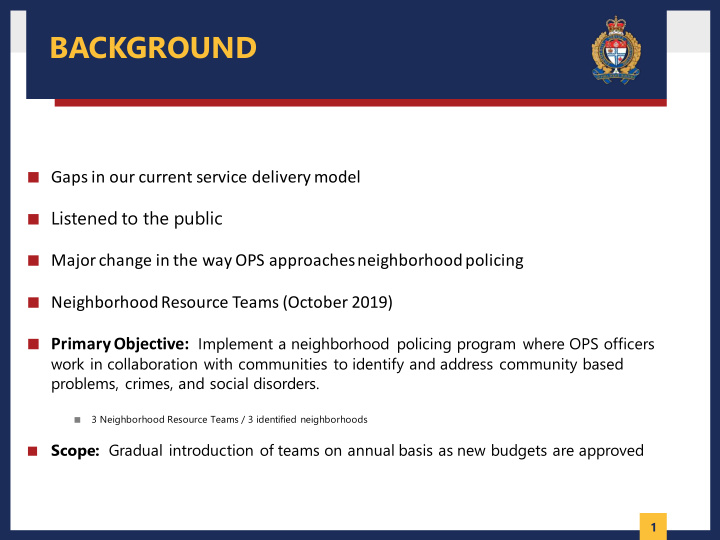



BACKGROUND ■ Gaps in our current service delivery model ■ Listened to the public ■ Major change in the way OPS approaches neighborhood policing ■ Neighborhood Resource Teams (October 2019) ■ Primary Objective: Implement a neighborhood policing program where OPS officers work in collaboration with communities to identify and address community based problems, crimes, and social disorders. ■ 3 Neighborhood Resource Teams / 3 identified neighborhoods ■ Scope: Gradual introduction of teams on annual basis as new budgets are approved 1
CONSULTATION AND PUBLIC INPUT OPS NHO Workshop Community Community agency and Stakeholder partner Workshop briefings Community Associations, Caldwell Family Centre, Carlington Community Housing, Community Assoc. and Health Centre, Community Health Care Neighbourhood Watch Vanier, Be Visible, Accessible and Centers, School Boards, Tungasuvvingat Inuit, Vanier Advocacy groups, City Community Service Centre, South East Actively Engaged; Get to Councillors Office, and Ottawa Community Health Centre, know People; Build Trust; members of public. Timbercreek Seek Involvement of Community; Build in Internal Community Operations Processes for Feedback; Policing Forum Set Clear Mandates; Capture and Record Work; Community associations, Crime Analysts, Traffic service organizations, and Divisional Case Set Performance Measures advocacy groups, OPS Managers, Community board members, City Development Councillors, students and Section,Performance, members of public. Planning & Analytics 2
OVERVIEW OF PILOT PROJECT ■ 3 Neighborhood Resource Teams will be piloted in ▫️ Vanier/Overbrook (Sector 25) ▫️ Heron Gate/South End (Sector 34) ▫️ Carlington/Caldwell (Sector 21) ■ Areas were selected based on statistics associated with past calls for service as well as the rate of violence, property crimes and shootings per 100,000 population for the neighborhoods, City, and Province ■ Each of these neighborhoods have experienced elevated rates of crime that exceed and sometimes double the rates city-wide 3
TEAM RESOURCES Each Neighborhood Resource Team will include: 8 Officers and 1 Sergeant: 5 Constables (5 year Fixed-Term) ▫️ 1 Community Police Officer (5 year Fixed Term) ▫️ 1 School Resource Officer (5 year Fixed Term) ▫️ 1 Traffic Officer (7 year Fixed Term) ▫️ 1 Sergeant (5 year Fixed Term) ▫️ ■ Neighborhood specific training, including cultural training, will be provided to increase officer awareness of the areas they are serving. 4
TEAM ACTIVITIES AND RESPONSIBILITIES ■ Regular & consistent police contact to address identified neighborhood-based crime/disorder issues ■ Prevention, intervention, and enforcement ■ Backed up by Frontline and Investigative Sections ■ Work towards long-term solutions to public safety and disorder issues ■ Dispute resolution ■ Working with vulnerable groups ■ Create meaningful and lasting relationships with residents 5
PROGRAM EVALUATION ■ Dr. Linda Duxbury and colleagues at Carleton University have been engaged to conduct an independent evaluation of the Neighborhood Policing program. ■ Information collected from this assessment will inform the evolution of the program ■ Key activities include: Public Survey (September/October 2019) - Baseline measurement of ▫️ public satisfaction in operating neighborhoods. Pulse Check (March/April 2020) - Survey stakeholders for early ▫️ feedback on program to make adjustments as needed. Public Survey (October, 2020) - Measure public satisfaction after one ▫️ year, what is the difference? Final Report – March 31, 2021 ▫️ Report back to PSB ▫️ 6
QUESTIONS ???????? 7
Recommend
More recommend